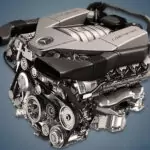The V8 series of Mercedes M273 engines with a volume of 4.7 and 5.5 liters was assembled from 2005 to 2015 and installed on many expensive models of the German concern, such as the W211, W221 and X164. These powertrains have earned a reputation as one of the most problematic motors in the company.
The V8-family includes: M113 E43, M113 E50, M113 E55, M119 E42, M119 E50, M119 E60, M156, M157, M177, M273, M278.
Specifications
| Production years | 2005-2015 |
| Displacement, cc | 4663 (M 273 KE 46) 5461 (M 273 KE 55) |
| Fuel system | distributed injection |
| Power output, hp | 340 (M 273 KE 46) 388 (M 273 KE 55) |
| Torque output, Nm | 460 (M 273 KE 46) 530 (M 273 KE 55) |
| Cylinder block | aluminum V8 |
| Block head | aluminum 32v |
| Cylinder bore, mm | 92.9 (M 273 KE 46) 98 (M 273 KE 55) |
| Piston stroke, mm | 86 (M 273 KE 46) 90.5 (M 273 KE 55) |
| Compression ratio | 10.7 |
| Features | no |
| Hydraulic lifters | yes |
| Timing drive | chain |
| Phase regulator | yes |
| Turbocharging | no |
| Recommended engine oil | 5W-40 |
| Engine oil capacity, liter | 8.5 |
| Fuel type | petrol |
| Euro standards | EURO 4/5 |
| Fuel consumption, L/100 km (for Mercedes S500 2007) — city — highway — combined |
17.4 8.5 11.7 |
| Engine lifespan, km | ~350 000 |
| Weight, kg | 205 |
The engine was installed on:
- Mercedes CL-Class C216 in 2006 – 2010;
- Mercedes CLK-Class C209 in 2006 – 2010;
- Mercedes CLS-Class W219 in 2006 – 2010;
- Mercedes E-Class W211 in 2006 – 2009; E-Class W212 in 2009 – 2011; E-Class C207 in 2009 – 2011;
- Mercedes G-Class W463 in 2007 – 2015;
- Mercedes GL-Class X164 in 2006 – 2012;
- Mercedes ML-Class W164 in 2007 – 2011;
- Mercedes R-Class W251 in 2007 – 2014;
- Mercedes S-Class W221 in 2005 – 2011;
- Mercedes SL-Class R230 in 2006 – 2011.
Disadvantages of the Mercedes M273 engine
- The unit is considered problematic and its weak point is timing drive.
- Wear of the intermediate gear leads to the replacement of the timing kit before 100,000 km.
- A common engine failure is a damper wedge in the exhaust manifold.
- Very often, oil oozes through the plastic plugs of the cylinder heads.
- Overheating of the engine can cause detonation and destruction of the walls of the combustion chamber.





